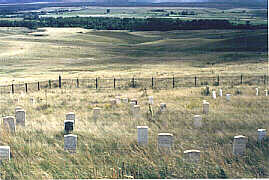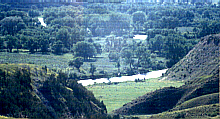At the onset, as expected, the non-combatants did cross Custer’s path, but in such number that he was unable to capture them. Custer retreated up the bluffs to cemetery ridge just under Custer hill to wait for Benteen’s reinforcements.
The Indians, having successfully terminated all advances by Maj. Reno and Capt. Benteen, and upon learning of more cavalry north of the village, withdrew to engaged Capt. Keogh’s right wing.
 If one is to believe Richard Fox’s technique of
“firing pin signature analysis” on spent cartridges
found at the scene. Capt. Keogh took up a skirmish
line just south of Custer hill, on top of the bluffs. The
Indians struck with such force that the line broke and
the right wing ran for salvation with Custer.
Salvation was not to be theirs. Of the estimated 120
men, only about 20 made it to Custer’s hill. Custer,
realizing that the end was within minutes, as his 100
or so remaining men were cut down by an ever
increasing Indian assault, is believed to have sent
some 40 men running on foot toward the river as a
diversion, while dispatching 9 horsemen to the south
to get help from now overdue Capt. Benteen. Neither
those on
If one is to believe Richard Fox’s technique of
“firing pin signature analysis” on spent cartridges
found at the scene. Capt. Keogh took up a skirmish
line just south of Custer hill, on top of the bluffs. The
Indians struck with such force that the line broke and
the right wing ran for salvation with Custer.
Salvation was not to be theirs. Of the estimated 120
men, only about 20 made it to Custer’s hill. Custer,
realizing that the end was within minutes, as his 100
or so remaining men were cut down by an ever
increasing Indian assault, is believed to have sent
some 40 men running on foot toward the river as a
diversion, while dispatching 9 horsemen to the south
to get help from now overdue Capt. Benteen. Neither
those on
foot or those on horseback survived. The
horsemen were cut down in seconds. The make-shift infantry, running as a diversion, were cut down as
they ran. 28 survivors took cover in a nearby ravine
where they watched Custer and the last remaining
men on the hill meet their doom. It is not known who
was the last soldier alive, but it is believed that he
was one of the 28 men who died in that ravine. The
final death toll was 210 calverrymen, civilians and
scouts. Among the dead were both of Custer’s
brothers and a nephew.
After the Indians withdrew from their assault on Maj. Reno and Capt. Benteen, The officers made one attempt to join up with Custer, moving about a mile and a half north before being turned back in heavy fighting. They now fortified the bluffs some 5 miles south and fought a gallant fight for the next two days. 58 men died, before the Indians, learning of a relief column approaching from the south, abandoned the attack and scattered in every direction. Although exonerated in a military inquiry, Maj. Reno’s failure to come to the rescue of the famous and flamboyant Lt. Col. Custer would haunt him to the end of his career. Within 4 years, most of the Indians involved were either captured, killed or had turned themselves in. A small band escaped to Canada. Both Sitting Bull and Crazy Horse were killed by Indian police while under arrest. . .
***THE END***


